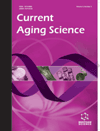- Home
- A-Z Publications
- Current Aging Science
- Previous Issues
- Volume 17, Issue 3, 2024
Current Aging Science - Volume 17, Issue 3, 2024
Volume 17, Issue 3, 2024
-
-
Anecdotal Evidence Elucidates the Aging Process
More LessOur group at Yuvan Research has conducted several experiments in recent years that have demonstrated the reversibility of aging through the use of a young plasma fraction, following a historical line of research that began with heterochronic parabiosis. However, a one-of-a-kind discovery, in the form of anecdotal evidence, has recently clarified many doubts about the nature of aging and rejuvenation, and the conclusions that Read More
-
-
-
Molecular Mechanisms of Polyphenols in Management of Skin Aging
More LessAuthors: Deepti Dwevedi and Ankur SrivastavaThe natural process of skin aging is influenced by a variety of factors, including oxidative stress, inflammation, collagen degradation, and UV radiation exposure. The potential of polyphenols in controlling skin aging has been the subject of much investigation throughout the years. Due to their complex molecular pathways, polyphenols, a broad class of bioactive substances present in large quantities in plants, have emerge Read More
-
-
-
Effects of Dietary Restriction on PGC-1α Regulation in the Development of Age-associated Diseases
More LessAuthors: Shefilyn Widjaja, Radiana D. Antarianto and Novi Silvia HardianyAgeing is the most significant risk factor for a number of non-communicable diseases, manifesting as cognitive, metabolic, and cardiovascular diseases. Although multifactorial, mitochondrial dysfunction and oxidative stress have been proposed to be the driving forces of ageing. Peroxisome proliferator-activated receptor γ coactivator α (PGC-1α) is a transcriptional coactivator central to various metabolic functions, of which Read More
-
-
-
Repercussion of Primary Nucleation Pathway: Dementia and Cognitive Impairment
More LessAuthors: Aditya Singh, Vaseem A. Ansari, Tarique Mahmood, Farogh Ahsan and Shubhrat MaheshwariNeurodegenerative diseases, such as Alzheimer's, Parkinson's, and prion disease, are characterized by the conversion of normally soluble proteins or peptides into aggregated amyloidal fibrils. These diseases result in the permanent loss of specific types of neurons, making them incurable and devastating. Research on animal models of memory problems mentioned in this article contributes to our knowledge of brain health and Read More
-
-
-
Neuroprotective Effects of Curcumin against Chronic Chlorpyrifos- Induced Oxidative Damage in Rat Brain Tissue
More LessBackground: Chlorpyrifos (CPF) is an organophosphate pesticide that inhibits acetylcholinesterase (AChE) activity. Investigations have also focused on its neurotoxicity, which is independent of AChE inhibition. Here, we evaluated the effect of CPF on oxidative indices in the brain tissue and explored the protective effect of curcumin (Cur) against its toxicity. Methods: Forty male Wistar rats were divided into five groups, each Read More
-
-
-
Blackcurrant Supplementation and Habitual Physical Activity Enhance Functional Capacity and Quality of Life in Previously Sedentary Older Women
More LessBackground: Loss of functional capacity negatively impacts the quality of life in older adults. Objective: This single-site randomized controlled study examined whether short- (one week) and long-term (three months) blackcurrant supplementations combined with habitual physical activity would improve functional capacity and quality of life in previously sedentary older women. Methods: Thirty sedentary, healthy older women we Read More
-
-
-
Neuroinflammatory Response and Redox-regulation Activity of Hyperoside in Manganese-induced Neurotoxicity Model of Wistar Rats
More LessAuthors: Olalekan B. Ogunro and Oluwaseun Ruth OlasehindeBackground: Excessive manganese exposure can lead to neurotoxicity with detrimental effects on the brain. Neuroinflammatory responses and redox regulation play pivotal roles in this process. Exploring the impact of hyperoside in a Wistar rat model offers insights into potential neuroprotective strategies against manganese-induced neurotoxicity. Objective: The study investigated the neuroprotective efficacy of h Read More
-
-
-
Prevalence and Related Factors of Dizziness Among Older Adults: A Cross-Sectional Study in Ardakan City, Iran
More LessBackground: Dizziness and balance disorders are directly related to aging in humans- Dizziness is one of the most important factors causing the burden of disability after the age of 65. Bearing in mind the increase in the elderly population in Iran and the world and the prevalence of dizziness in old age, early diagnosis of dizziness and determination of the factors affecting its severity facilitate its treatment and are effective in p Read More
-
-
-
Loneliness, Psychological Well-being, Depression, and Social Participation in the Older Persons: Rural and Urban Differences
More LessAuthors: Zeynep G. Demir and Mahmut YilmazIntroduction: The purpose of this study is to compare the loneliness, psychological well- being, depression, and social participation of elderly people living in Turkish society between rural and urban areas. The sample group of the study, in which a correlational survey model was used, consisted of 610 elderly adults. Method: The study population consists of two groups: the first group consists of individuals over 65 years of age livi Read More
-
Volumes & issues
Most Read This Month
Article
content/journals/cas
Journal
10
5
false
en

Most Cited Most Cited RSS feed
-
-
Polyphenols and Aging
Authors: Brannon L. Queen and Trygve O. Tollefsbol
-
- More Less

